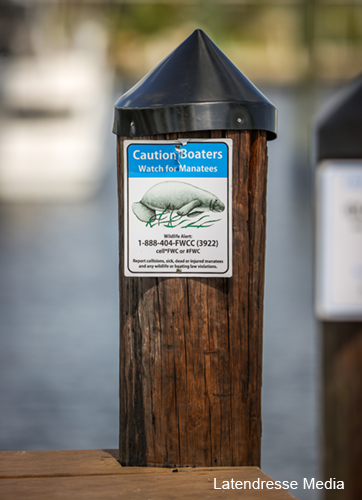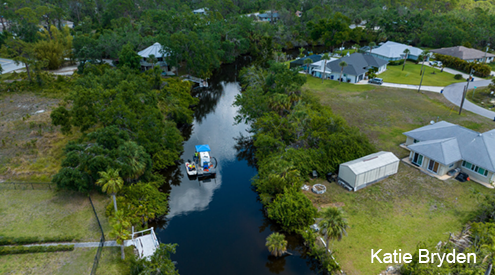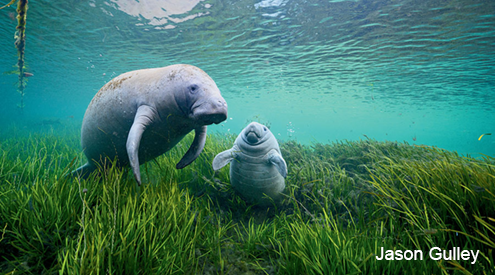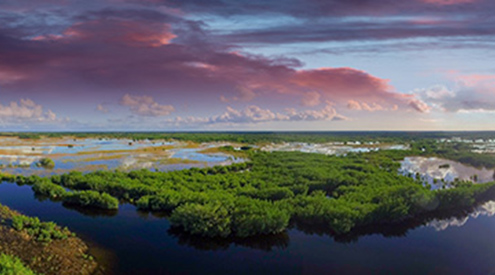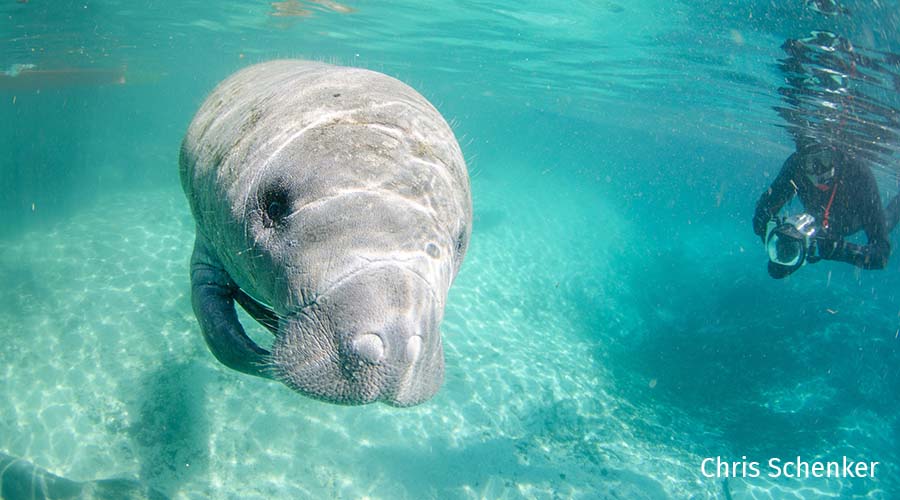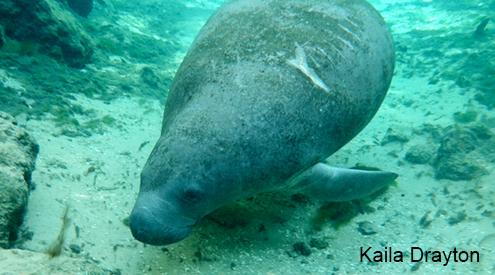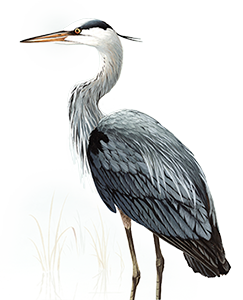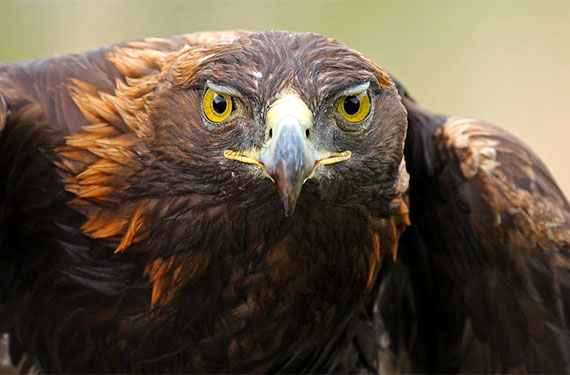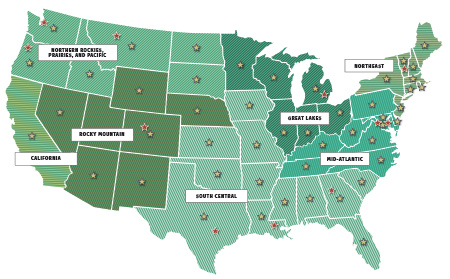Manatees are a beloved marine mammal along the Gulf Coast. These gentle, slow-moving herbivores exist in close proximity to human activity, spending summers cruising along ocean waves and winters floating through warm freshwater springs and even industrial power plant discharge sites.
As Florida’s population continues to grow exponentially, so do the threats facing manatees, their food and their habitats. NWF is working on-the-ground in Florida and Alabama to protect the West Indian Manatee for generations to come.
Manatee Conservation
Boat strikes are a major threat to manatees, and this threat has been growing in recent years as more recreational boaters are sharing the water with wildlife. Because manatees are generally slow-moving animals, they are unable to move out of the way from rapidly-approaching boats, possibly due in part to not being able to hear the low-frequency engine pitch. Spinning boat props hit and maim manatees, and these hits can be lethal. Recent research has determined that a whopping 96% of adult Florida manatees bear scars from boat strikes, and 1 in 4 manatees have been hit by a boat on 10 or more separate occasions. In addition to causing pain and stress, these repeat strikes may impair manatee mobility and health long term.
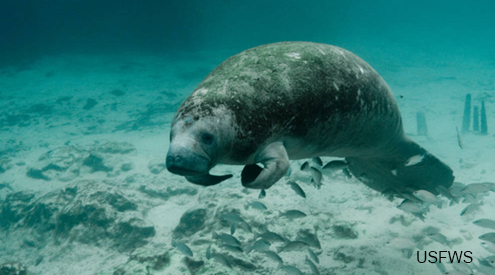
Manatees are herbivorous grazers. They eat seagrass and other submerged aquatic plants, and they need to eat a lot of it every day to maintain their enormous body weight of ~1,000 pounds. Unfortunately, poor water quality in Florida has been causing a decline in seagrass for many years, leaving manatees to quite literally starve to death. Today, there is an ongoing Unusual Mortality Event (UME) of Florida manatees due to exceedingly poor water quality in manatee habitats that makes it difficult for seagrass to grow; because of this, over 1,100 manatees died in 2021 and over 800 died in 2022. This is the first manatee UME caused by starvation. Additionally, runoff of pollutants into the Gulf of Mexico has been causing repeat Red Tide events. Red Tides are characterized by huge blooms of a specific neurotoxic algae (Karenia brevis) that can poison manatees, making them seize and drown. This contributed to the record-breaking manatee mortality count in 2021.
In the wintertime when the ocean temperature drops, manatees seek refuge in stable warm waters (>68 °F). Many natural warm water springs exist throughout Florida. However, due to impediments such as physical barriers (i.e. dams) and low water flow levels, manatees no longer have access to many of these sites. Instead, they have become accustomed to congregating by industrial power plants where warm water effluent is discharged into the seawater. Like many marine animals, manatees have high site fidelity, meaning they tend to return to the same sites every winter. As industrial power plants begin to close and transition to cleaner energy sources, there is a need to restore manatee habitat throughout Florida so they can access natural warm water refuges.
Listed as “threatened” by the US Fish & Wildlife Service, manatees face multiple compounding and growing threats. It will take consistent work and dedication to create lasting solutions. That’s why NWF is actively working to educate boaters, protect and restore natural manatee habitat, and improve water quality to save this beloved species.

Our Work
The National Wildlife Federation uses its full range of communications and educational tools to increase the visibility of the manatee’s plight, and the continued need to support conservation for this charismatic marine mammal. In coordination with partners on local, state and federal levels, the National Wildlife Federation is working to protect manatees by (a) improving water quality (b) protecting and restoring critical habitat and (c) educating the community about ways to protect manatees and seagrass meadows.
How You Can Help
Manatees are a federally protected species. While they are mostly found in Florida during cooler months (Nov - Mar), they can be spotted in creeks and bayous in other Gulf states during the summer. There are a number of things you can do as a Gulf resident or a tourist to help them:
- Make room for manatees. Give plenty of space in creeks or waterbodies where manatees have been spotted.
- Slow your boat. Boat strikes are one of the most common injuries to manatees.
- Report a sighting to help improve the research and protection of these incredible creatures.
- Reduce or avoid using fertilizer that can feed algae growth that impacts manatees as well as other fish and wildlife.
- Show your support for projects and policies that will benefit manatees. Input from the public is an important part of protecting fish and wildlife. Keep an eye out for our emails about issues that impact manatees.
- For emergency issues such as an injured manatee or harassment of these docile creatures, please contact the proper authorities on their 24-hour hotline:
- Florida - Call the Florida Fish and Wildlife Conservation Commission at 1-888-404-FWCC (1-888-404-3922).
- Alabama or Mississippi - Call Dauphin Island Sea Lab’s Manatee Sighting Network at 1-866-493-5803.
- Louisiana - Boaters are cautioned to be aware of manatees. If you spot an injured manatee, immediately call Louisiana Fish & Wildlife Agency at 1-800-442-2511
- Texas - While uncommon, manatees do occasionally visit the Texas coast. For distressed manatees, call the Texas Marine Mammal Stranding Network at 1-800-9MAMMAL.
